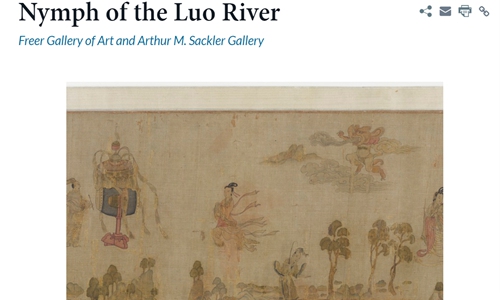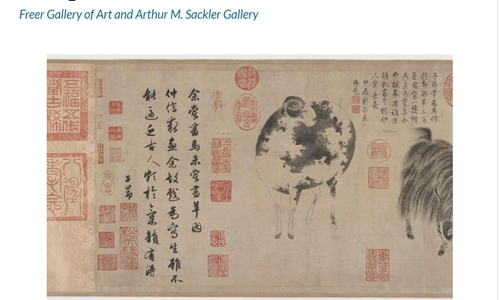HOME >> ARTS
How western visitors enjoy ancient Chinese paintings from Smithsonian digital image release
By Chen Xi Source:Globaltimes.cn Published: 2020/3/6 5:19:20

Photo: Screenshot of The Smithsonian Institution website
Chinese netizens expressed great interest in the digital images of Chinese relics at US-based museums after the Smithsonian Institute, the world's largest museum, unveiled 2.8 million digital images from its collection with plans to access to over 3 million images by the end of 2020.
According to The Paper, the digital images include the Freer Gallery of Art collection, which has over 12,000 Chinese relics from the Shang Dynasty (C. 1600 BC-1046 BC), Buddha sculptures in the Northern Qi Dynasty (550-577) and porcelain from the Song Dynasty (960-1279).
Over 1,200 Chinese paintings include a copy of the famous work The Nymph of the Luo River created during the Southern Song Dynasty (1127-1279), and the original Sheep and Goat from the Yuan Dynasty (1279-1368).
The Nymph of the Luo River was created by Gu Kaizhi, a painter from the Eastern Jin Dynasty (317-420). The work depicts a love story from a poem about a prince who encounters a goddess along the Luo River in Central China. The original was lost, and only three official copies were made during the Song Dynasty (960-1279). The existing copies are held at The Palace Museum in Beijing, the Liaoning Provincial Museum, and the Freer Gallery of Art in the US.

Photo: Screenshot of The Smithsonian Institution website
Sheep and Goat was created by Chinese calligrapher and painter Zhao Mengfu, whose specialty was drawing horses. The work is the only painting from Zhao that isn't a horse.
Although Chinese netizens have shown strong interest in the paintings, the ancient art work may be difficult for foreign visitors to understand due to the cultural differences between the East and West.
"To enjoy the Chinese paintings, one cannot only look at the content, but also needs to understand the story behind the painting because Chinese artists use subtle elements in their work to express personal emotions," Feng Shushan, a painter, and dean of the China Yanhuang Academy of Ancient Painting and Calligraphy, told the Global Times on Thursday.
Feng noted that Western art has always used realistic techniques like the sketch approach to draw content. While Chinese traditional paintings are more focused on imagery exploration.
Feng offered the example that The Nymph of the Luo River is considered to be the first painting adapted from Chinese literature, and the reason why it is famous is due to the painting's back story.
"In the painting, Gu expressed the prince's complex moods of joy and sadness, the gain and loss during the pursuit of love. If foreign visitors unfamiliar with the love story, they will not completely understand the work that features many symbolic elements," Feng explained.
RELATED ARTICLES:
- Children across world create paintings to support China's fight against novel coronavirus epidemic
- Artist Zhang Xinjian exhibits new paintings, combining Chinese ink wash and Western techniques in Beijing
- 7,000-year-old paintings made from animal blood said to be found on rock face in Northeast China
Posted in: ART